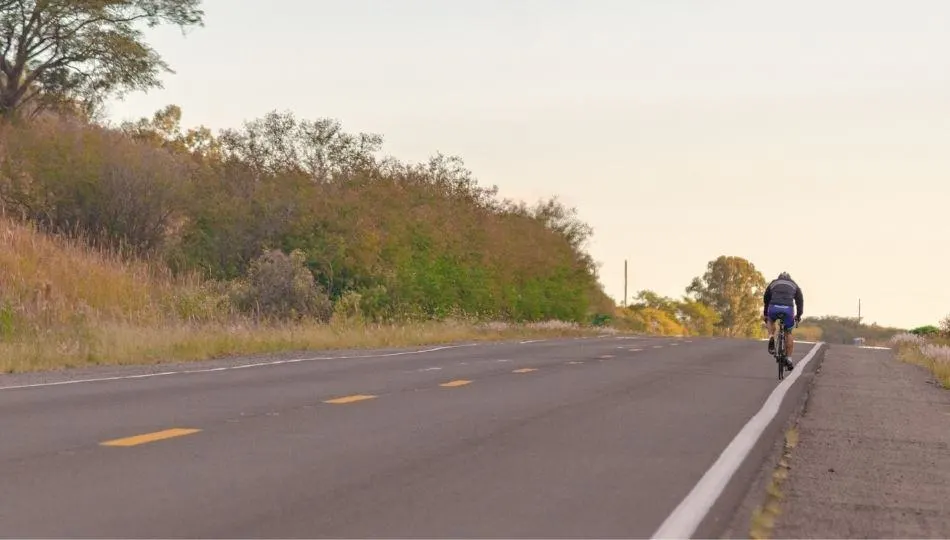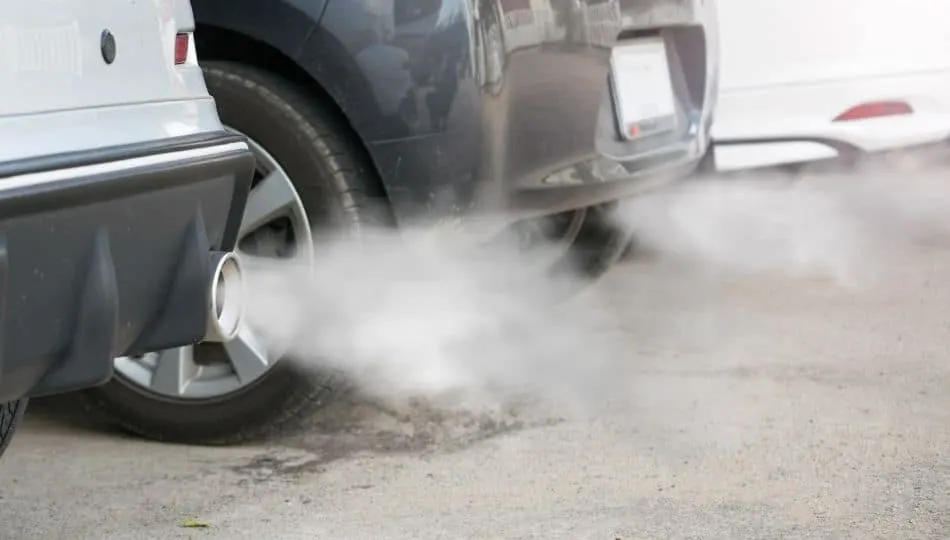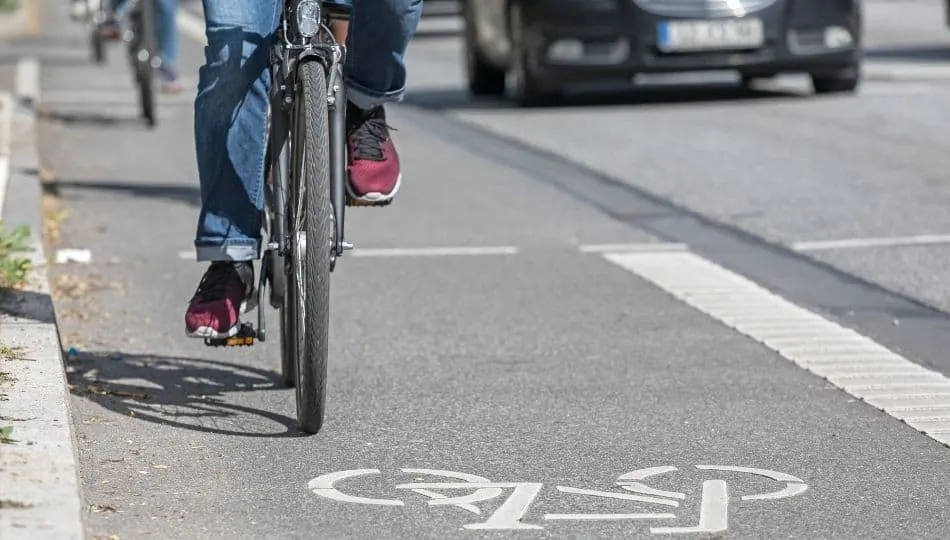
Highways have three features; wide, flat and clear terrain. Ideal terrain in fact, for cyclists. But they weren’t originally designed for cyclists. They were designed for motor vehicles. And cyclists on highways don’t always mix well for various reasons.
Some of the reasons it’s not a good idea for cyclists to be on the highway are:
- Some states prohibit cycling on them entirely;
- There are very few places for cyclists to cross safely;
- You need to have a lot of experience cycling to ride on the highway;
- Cyclists have to deal with a lot of car fumes;
- Sections of the highway may have T-Junctions;
- Dealing with roundabouts;
- Dealing with parked cars;
- And potholes.
We encourage that you use highways – if it’s legal in your area – cautiously if you still wish to go ahead. Below, we go into more details of the dangers of highways and what you can do as a cyclist to mitigate these risks and ride safer.
Reasons Why Cycling On Highways Isn’t Good
When considering biking on the highway, it sounds like a nice idea. With wide lanes, there is plenty of space for cyclists to bike on the side. The flat terrain also makes biking optimal since you won’t have to deal with many hills or slopes. Furthermore, highways are designed to get to your destination faster, even if cyclists aren’t able to go at a hundred miles per hour.
But when you take a closer look, there may be some reasons why you shouldn’t cycle on the highway. Let’s take a look at some of them…
1. It Could Be Illegal
The first reason is that in America, there could be laws that prohibit cyclists from even using the highways or interstates. The only exception to that is that there is specific signage that permits bikes to be on them. Some states have made it perfectly legal, though cyclists are required by law to take the first off-ramp marked with signs for bikes to use.
States that allow cycling on highways are:
- Alaska
- Arizona
- Idaho
- Montana
- Nevada
- New Mexico
- Oregon
- Texas
- Utah
- Washington
- Wyoming
And then there are some states that allow you to use some of the interstate. It’s restricted based on what sections of the interstate are designed for bike use. Those states are:
- California
- Colorado
- Florida
- North Carolina
- Oklahoma
If you’re wondering why these specific states are fine with this comes down to the fact there is a lower population density when you compare it to other states. That or they have large areas that are much lower than others.
This makes it safer to be on the interstate as there won’t be as much traffic to contend with. The reason it’s illegal in other areas is that because there is so much traffic, it’ll be harder and more dangerous for cyclists to be on interstate and highways around the area.
2. There Are Few Places To Cross Safely
Even in cases where it is legal to be driving on the highway, cycling on them can be dangerous for many other reasons. One of which is the fact that the speed limits will be much higher in these areas and thus vehicles such as shipping trucks, semis, logging trucks, and other vehicles will be going faster.
The problem gets even worse when you consider the fact that most freeways have very few places to cross safely when you need it to. Pair that up with highways being wider, you’re realistically crossing several lanes of traffic on foot with vehicles that will be driving quickly and will be unable to stop in time.
3. Highway Riding Requires An Experienced Cyclist
Unlike within towns and cities, you’ll be dealing with significantly larger vehicles while biking. There will still be smaller motorized vehicles of course but it won’t be as dense when compared to in town. With that in mind, you’re going to need to have some experience with cycling overall.
The reason we say that, is that when dealing with larger vehicles, they’re not going to be able to stop as fast – or at all – and they’ll have much larger blind spots than smaller vehicles. Accounting for those things will take some experience biking through the city.
The other highways are for more skilled cyclists is the fact that one mistake on the highway could end up with you killed.
4. Car Fumes Can Damage Your Lungs And Cycling Performance
Even though highways are designed to have spaced out traffic, it still doesn’t change the fact that you’ll have to deal with some level of car fumes. In fact, you may be dealing with just as much car fumes on the highway as you would with in the city considering larger vehicles will be releasing more fumes into the air.

These fumes are incredibly dangerous since it stems from gas which has several chemicals in them including black carbon, nitrogen dioxide, and fine particulate matter from diesel exhaust. All of these things can have an adverse effect and it doesn’t take too much of it at all.
One study found that cycling or walking on a busy street on a main street during rush hour can have no or reversed health benefits for you. The research also uncovered that a cyclist will experience a reduction in lung function and harm exercise performance.
Even though this is on busy streets in the city, this same logic can be applied to the highway. You’re still going to be dealing with car fumes. The other thing to be keeping in mind is that in several states, the highway is temporary and you’ll be forced to head back into town eventually. Why risk getting higher exposure to car fumes when you could plan out another route that has less traffic.
5. T-Junctions & Intersections
Whether it’s t-junctions or intersections, this particular design is dangerous for cyclists and highways have some level of these involved. These types of roads are some of the most common accidents that you can experience.
And in most cases, this can stem from one of two major problems:
- Either the vehicle that’s emerging onto a main road or highway collides with a cyclist that’s travelling past that junction; or
- The driver of the vehicle fails to give way when they’re turning across oncoming traffic and the cyclist is travelling the opposite direction with no intention of turning off.
There have been several arguments about cyclists being on the highway due to these intersections and it makes sense why. Many argue that cyclists around that area are difficult to spot. They’re not wrong about that as the Highway Code is written on the premise that cyclists could possibly be hard to spot in some of the more difficult road layouts.
6. Sections With Roundabouts
Along with t-junctions you might also be dealing with roundabouts. While you won’t be running into these at all on the highway, these could be placed in areas that will let you get onto the highway.
Similar to t-junctions, this is an area where a lot of accidents happen, particularly in ones that have multiple exits. In many cases it stems from motorists not being diligent enough and either emerging from a side road without checking for a cyclist or overtakes a cyclist and turns off the roundabout, giving little to no room for the cyclist and the cyclist getting hit.
7. Parked Cars On The Highway
Though this happens far more often in city streets, there can be times where cars will be parked on the side of the road. This can be problematic for a few key reasons.
The first reason is that sometimes you can get knocked off your bike if the driver or passenger gets out of their car. The door swings open and it’ll immediately block your path.
The second reason is that as a general rule of thumb, you want to be giving cars wide space in order for them to open the door properly and not hit you when you’re riding. This is harder to do when you are on a highway as you’ll be dealing with speeding vehicles and the bike lanes on highways aren’t that big to begin with. You’ll likely be forced to drive on the highway itself for a moment but it’s not always going to be safe when you consider these possibilities.
8. Potential Potholes
The final reason is another common danger for cyclists: potholes. There are all kinds of highways. Some are maintained very well while others aren’t so much. Because these highways are used regardless by heavy vehicles and cars, this leads to roads wearing down, curving, and eventually developing pot holes.
Potholes are extremely dangerous and have killed several cyclists as result of their placement. In certain circumstances, you simply can’t avoid a pothole and have to find some other way around it. It’s key that you are paying attention to these when cycling.
How To Safely Ride On Highways If It Is Allowed
Despite all of these reasons though, a highway may be the best viable option for you to commute at the moment. Provided that it is legal for you to be riding on the highway, here is how you can ride on the highway – and in town – in a much safer manner.

Remember The Basics
One myth that many car drivers think is that a cyclist is a second-class citizen of the road when that’s false. Cyclists are expected to follow all of the same traffic laws as any car would. What that means is it’s key that you follow the rules of the road while also navigating with much larger and faster vehicles.
To be prepared for this, remember the rules of the road – and especially around highways. You also want to keep in mind the basics of biking as well in terms of safety. This means:
- Wearing a helmet on every ride. Even if you’re 18+ and don’t legally have to wear one, highways and roads are still dangerous and a helmet could save your life if you end up in an accident.
- Be sure to be wearing bright and visible clothing. Add in reflexive tape or patches as well will help.
- Obeying the rules of the road like stopping at stop signs and red lights.
- Always be biking with traffic, not against it.
- Always be in control of your bike at all times. Bike at speeds where you’ll be able to react quickly if something unexpected happens.
- Yield to walkers and other vehicles.
- Avoid riding your bike in low-light or dark conditions unless you have rear bike lights and reflectors. It’s prohibited on the highway regardless of whether you have these or not though.
Understand Highway Rules
With the basics in mind, you can then build upon those rules when going on the highway. Because you’re dealing with a whole different way of traffic, the rules will be shifting and you’ll need to accommodate that.
- First, be sure to be as far right on the highway as you possibly can. Always try to be on the paved shoulder whenever possible.
- Check behind yourself often and be listening for approaching cars. One way to make this easier for you is to have a helmet mounted or eyeglass-mounted mirror
- Because there will be several large vehicles passing by, you’ll want to be bracing yourself often for passing vehicles. Even small ones can cause quite an impact too. To do this, grip the handlebars firmly and lower your body down to lessen wind resistance. You also want to ensure you’re as far right as you can be.
- Be mindful of other highway rules as well. Just because you are on a bike doesn’t mean that you’re not immune to traffic violations. Follow the rules of the road.
Tips & Tricks To Make Highway Cycling Easier
As a cyclist on the highway everything changes. And while there are plenty of rules out there that are easy to grasp, there are some extra tips and tricks to make highway cycling easier on you. These are tips that are offered by skilled and knowledgeable coaches, physiologists and other cyclists from around the world.
- Even if you’re doing a short commute, positioning on a bike is still important. How you position yourself on your bike can cause problems for you later that day or down the road. To avoid muscle soreness and fatigue, avoid hunching your shoulders. Instead, tilt your head every few minutes to stave off tight neck muscles. What’s even better is to stop and admire the scenery
- If you have a particularly long commute, pay attention to how the saddle is positioned. Both rearward and forward on the saddle will emphasize completely different muscle groups. This is particularly important when on long climbs as the different positions gives muscles a break.
- Avoid moving your upper body. Let your back serve as a fulcrum with your bike swaying from side to side beneath it.
- Pull on the bar with a rowing motion to counter the power that your legs are producing. This transfers energy to the pedals rather than on a wasted movement
- If there is no chance to slow down for an obstacle, quickly pull up on the handlebar to lift the front wheel. It’ll still damage the rear wheel, or it could suffer a flat, but it’ll prevent an impact on the front which could lead to a crash.
- Avoid creeping forward on the saddle and hunching your back when you are tired. It’s better to shift gears to a higher one and stand up to pedal periodically. This prevents stiffness in your hips and back.
- The more aerodynamic you are, the faster you’ll go at no extra energy. This means avoid splaying your elbows out and keeping them tucked in at your side.
- Stay far enough in the traffic lane to avoid being hit by doors on parked cars if they suddenly open. You will likely get some honks from drivers who don’t fully understand why you won’t pull over to let them pass though. I say a honk in the ears hurts but having your face slammed into a door is much worse.
- On roads that have no shoulder, ride in the right wheel track of cars to ensure you’re not blending into the scenery by the edge of the road. This also gives you about 3 to 4 feet of space from the edge which allows you to dodge potholes and deal with wind gusts.
- If you’re in a bike lane and a car is making a right turn in front of your path, don’t turn left and swerve around them. Slow down, stay in the lane and let the car turn.
Be Mindful While on The Highway
At the end of the day, it’s better for you to avoid the highway. Even in cases where it is legal to bike on the highway, it’s best to avoid it unless it is absolutely necessary to get to where you need to go. There are several dangers for cyclists within the cities and on a highway there are even larger dangers there that might not be worth the risk.
